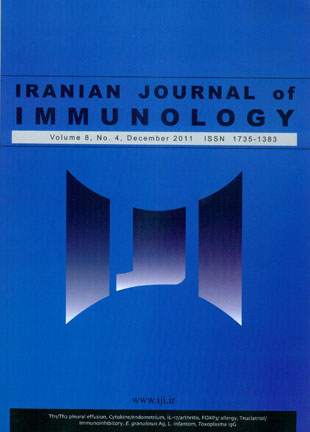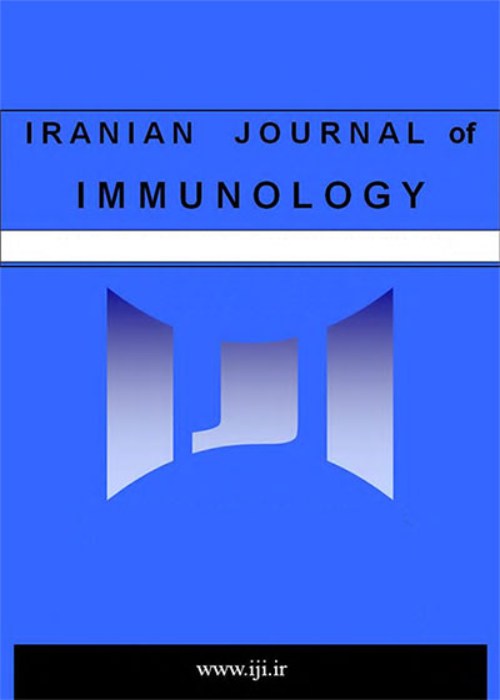فهرست مطالب

Iranian journal of immunology
Volume:8 Issue: 4, Autumn 2011
- تاریخ انتشار: 1390/11/15
- تعداد عناوین: 8
-
-
Page 195BackgroundThe alteration of Th1 and Th2 cytokine levels is the subject of controversy inpleural effusions caused by malignancy, a situation that favors a Th2 immune response.ObjectiveTo examine the different levels of IL-4 and IL-10 (Th2 cytokines), and IL-2 andinterferon-γ (IFN-γ) (Th1 cytokines) in malignant and non-malignant pleural effusions.MethodThe cytokine levels in pleural fluid of 62 patients with malignant pleural effusion(44 with lung cancer and 18 with extrathoracic tumors), 8 with tuberculous and 8 withcongestive heart failure pleural effusion were analysed using enzyme-linked immunosorbent assays.ResultsIL-2 was below the detectable concentration of the assay. A significant decrease in IFN-γ level was observed in malignant but not in congestive heart failure cases compared to tuberculous cases. IL-10 levels were higher in malignant and tuberculous pleural effusions than in congestive heart failure pleural effusions, however, this difference did not reach the significant level. IL-4 levels were also increased non-significantly in lung cancer pleural effusions compared to the other groups.ConclusionOur results show a wide variation in IL-4, IL-10, and IFN-γ levels in malignant pleural effusions, a pattern which was not convincing enough to differentiate the cause of effusion.
-
Page 201BackgroundRepeated Implantation Failure (RIF) is one of the most intricate obstacles inassisted reproduction. The cytokine and chemokine composition of uterine cavity seem toplay important roles in the implantation process.ObjectiveTo compare the cytokine profile in the endometrium of normal fertile women and those with repeated implantation failure.MethodsAfter enzymatic digestion of endometrial tissues, whole endometrial cells and endometrial stromal cells from RIF and normal fertile women were cultivated and stimulated for cytokine secretion. The levels of IL-10, TGF-β, IFN-γ, IL-6, IL-8 and IL-17 in culture supernatants of the two groups were assayed by ELISA and compared together.ResultsEndometrial stromal cells and whole endometrial cells of normal fertile women produced higher levels of IL-6, IL-8 and TGF-β compared to RIF group, although this difference was statistically significant only in endometrial stromal cells (p=0.005, 0.002 and 0.001, respectively). In addition, endometrial stromal cells of normal fertile women produced lower levels of IL-10 in comparison with RIF group (p=0.005).ConclusionDisturbances in cytokine production at the feto-maternal interface could be a cause of implantation failure. A pro-inflammatory cytokine milieu seems to be pivotal for successful implantation.
-
Page 209BackgroundIL-4 is a cytokine that induces differentiation of naive helper T cells into Th2cells. Once activated by IL-4, Th2 cells subsequently produce additional IL-4.ObjectiveTo examine the effect of IL-4 on IL-17 production and its effect in Collagen-Induced Arthritis (CIA) mice.MethodIn this study, a chicken collagen-II-induced experimental arthritis (CIA) model was used in DBA/1 mice to investigate the relationship between IL-4 and IL- 17 as well as other inflammatory factors. On the 38th day after the mice were induced with CIA, the expression of IL-17 and IL-4 as well as IFN-γ and IL-13 in sera of the mice was measured by QRT-PCR and ELISA.ResultThe result of QRT-PCR analysis of IL-17 and IL-4 mRNA levels in the spleen showed that IL-17 is increased significantly at the onset of CIA in the spleen (p<0.01). Meanwhile, IL-17 is generally reduced at the peak of CIA but IL-4 is increased significantly at this peak in the spleen when the weight of the animal was taken into consideration (p<0.05).ConclusionIL-4 can be involved in the production of IL-17 at especially the peak of CIA. These results imply that the inhibition of IL-17 may decrease the expression of IL-1β and IL-6 production which will result in the aggravation of arthritis.
-
Page 218BackgroundRegulatory CD4+T (Treg) cells are effective in maintaining immune tolerance.ObjectiveTo investigate single nucleotide polymorphisms (SNPs) of Transforming GrowthFactor β-1 (TGF-β1) and Forkhead Box Protein 3 (FOXP3) genes in Iranian patients withallergic rhinitis (AR).MethodsVariations at codons 10 and 25 of TGF-β1 and FOXP3 atpositions -3279 A>C and -924 A>G were evaluated in AR patients and compared withcontrols. In a case-control study, 155 AR patients and 163 allergy-free controls weregenotyped using polymerase chain reaction sequence-specific primer (PCR-SSP) technique.ResultsThe analysis of the frequency of these SNPs showed that the haplotype formed by FOXP3 -3279 A allele occurred significantly more frequently in patients than controls (odds ratio=1.44, 95% CI=1.312-2.66; p=0.001).ConclusionOur results suggest that polymorphism in FOXP3 gene is associated with susceptibility to AR.
-
Page 226BackgroundSalvia mirzayanii, a native plant to Iran, is shown to have immunomodulatoryeffects on lymphocyte proliferation.ObjectiveTo identify the bioactive immunomodulatory compound(s) present in S. mirzayanii.MethodsThe crude extract was fractionated to five fractions in two steps using different solvents. The fractions were subjected to bioassayguided fractionation. All the fractions were tested for bioactivity on human activatedperipheral blood lymphocytes (PBLs) using cell proliferation assay.ResultsThe methanol fraction (Fr. M) showed the highest inhibitory effect on PBLs compared to other fractions. Fr. M was applied on a gravity column chromatography for further fractionation. Resultant fractions, demonstrated inhibitory effects at higher concentrations. Fr. 4 with an 18.9 ± 0.2% inhibitory activity at 200 μg/ml and with the highest quantity was applied on preparative TLC plates for further purification. The final purified compound was identified as teuclatriol, a guaiane sesquiterpene, by NMR analysis. This compound showed a significant antiproliferative effect on human activated-peripheral blood lymphocytes (IC50, 72.8 ± 5.4 μg/ml).ConclusionTeuclatriol was found to be one of the compounds responsible for the immunoinhibitory effect of Salvia mirzayanii. We suggest further studies on teuclatriol, exploring its mechanism of action as an immunomodulatory compound.
-
Page 236BackgroundCystic echinococcosis (CE), also known as echinococcosis/hydatidosis, is oneof the most important parasitic diseases in the world. It enhances both humoral and cellular (Th1 and Th2) responses in infected host. Different antigens of the worm may favor the Th1 or Th2 immune responses in CE patients.ObjectiveTo evaluate the humoral and cellular immune responses of Balb/c mice against the crude and excretory/secretory (E/S) antigens of in vitro reared Echinococcus granulosus adult worms.MethodsA total of 20 Balb/c mice divided into 5 groups of 4 mice each. Three groups of mice (n=4) were immunized with crude, E/S and an immunodominant antigen of in vitro reared Echinococcus granulosus adult worms on day 1 and 28. The fourth and the fifth groups were negative control groups and received PBS plus adjuvant, or nothing, respectively. Two weeks after the second injection, the mice were killed and their blood was collected for determining antibody responses, and their spleens were employed for proliferation assay. Total IgG was measured by indirect ELISA. Spleen cells of immunized mice were cultivated and exposed to different antigens of adult worms including E/S and crude antigens. Levels of IFN-γ, IL-12, IL-4 and IL-10 weremeasured in the recovered cell culture supernatants by capture ELISA.ResultsTotal IgGassay showed the highest level of antibody produced in mice immunized with crude antigens. Proliferation assay showed a statistically significant production of cytokines in the mice immunized with crude antigens (p<0.05). The highest levels of IFN-γ, IL-12 and IL-4 were produced in mice immunized with crude antigen of the in vitro reared Echinococcus granulosus adult worms followed by E/S antigens. Immunodomonant antigen induced the lowest levels of cytokines (IL-12, IFN-γ, IL-4 and IL-10) in immunized mice.ConclusionSignificant levels of Th1 related cytokines (IFN-γ and IL-12) were produced in Balb/c mice immunized with crude antigen of the in vitro reared Echinococcus granulosus adult worms.
-
Page 244BackgroundVisceral leishmaniasis (VL) is caused by Leishmania infantum inMediterranean basin and is an endemic disease in some parts of Iran. Canines are the mainreservoirs of VL in most of the endemic areas. Different serological methods have beenintroduced for diagnosis of canine visceral leishmaniasis (CVL).ObjectiveIn this survey aFucose-Mannose Ligand (FML) ELISA, using native L. infantum antigen, was developed and its validity for detection of infected dogs in comparison with direct agglutination test (DAT) and PCR was evaluated.MethodsBlood samples of sixty ownership dogs (≤ 3 years old) were collected from Meshkin-shahr district in Ardabil province, North-west of Iran. Sera were separated for serological assays (DAT and FML-ELISA) and the buffy coats were collected for molecular evaluation.ResultsTwo out of the 60 (3.33%) samples were found to be positive (antibody titer of ≥ 1/320) in DAT while seven of the 60 (11.66%) samples were positive by FML-ELISA. Nine out of 60 (15%) buffy coat samples showed a band about 680 bp indicative of L. infantum in PCR. Three out of 60 dogs had Kala-azar symptoms and were positive by PCR and FML-ELISA, while two of these three dogs had antibody titers >1/320 in their serum samples. The sensitivity and specificity of FML-ELISA for the detection of CVL in both symptomatic and asymptomatic dogs were found to be 77.8% and 100%, respectively.ConclusionConsidering the acceptable sensitivity and high specificity of FML-ELISA, use of this serological method can be recommended for epidemiological surveys of CVL.
-
Page 251BackgroundToxoplasmosis is well known as an important infection in pregnant women.Although many serologic methods are available, diagnosis of early Toxoplasmosis may beextremely difficult.ObjectiveTo detect the Toxoplasma IgG antibodies developed at theearly stage of infection in pregnant women.Methods225 pregnant women, who were in the 2nd to 4th month of their pregnancy, enrolled in this study. Anti-toxoplasma IgG, IgM and IgG avidity were evaluated by ELISA method.ResultsThe patients were categorized into three groups as follows: Group A, 124 cases; IgG+, IgM+, 55.1%; group B, 99 cases; IgG+, IgM-, 44%; and group C, 2 cases; IgG -, IgM +, 0.9%. Fifty five percent of the pregnant women had positive IgG and IgM among which 7.1% had low avidity which revealed an active infection in the pregnant women. In the current study, 44% of pregnant women had positive IgG and negative IgM, all of which had high avidity, which is an indication that in our population the level of toxoplasmosis infection is high and most women have had contacts with this parasite before pregnancy.ConclusionIn this study, the low avidity test was 7.1% showing that the occurrence of toxoplasmosis infection is still a serious issue. Observation of 45.8% high avidity among group A suggests that either IgM has a high half-life or there is a false positive IgM as a result of rheumatologic disorders. Therefore, avidity test is important in predicting maternal toxoplasmosis which is of value in disease treatment.


